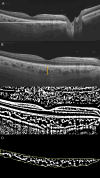Choroidal Vascularity Index in CHM Carriers
- PMID: 38983966
- PMCID: PMC11182189
- DOI: 10.3389/fopht.2021.755058
Choroidal Vascularity Index in CHM Carriers
Abstract
Purpose: To assess the choroidal structure using the Choroidal Vascularity Index (CVI) and analyse choroidal changes in choroideremia (CHM) carriers.
Material and methods: Female CHM carriers, genetically characterized, and a control group were recruited at the Eye Clinic of Careggi Teaching Hospital, Florence. The patients underwent a complete ophthalmic evaluation and retinal imaging. In particular, the Stromal Area (SA), Luminal Area (LA), Total Choroidal Area (TCA), CVI, and Subfoveal Choroidal Thickness (SFCT) were calculated for each eye using Optical Coherence Tomography (OCT) examinations.
Results: Twelve eyes of 6 CHM carriers and 14 eyes of 7 age-matched controls were analysed. The mean SFCT was 270.9 ± 54.3μm in carriers and 281.4 ± 36.8μm in controls (p = 0.564); LA was 0.99 ± 0.25mm2 and 1.01 ± 0.13mm2 (p = 0.172); SA was 0.53 ± 0.09mm2 and 0.59 ± 0.07mm2 (p = 0.075), and TCA was 1.53 ± 0.34mm2 and 1.69 ± 0.19mm2 respectively (p = 0.146). Mean CVI measured 64.03 ± 3.98% in the CHM carriers and 65.25 ± 2.55% in the controls (p = 0.360).
Conclusions: The CVI and CVI-related parameters (SA, LA, and TCA) do not differ between CHM female carriers and controls. These findings reveal a preserved choroidal vasculature in eyes with RPE impairment and support the primary role of RPE in the pathogenesis of CHM disease.
Keywords: CHM; CVI; OCT; carriers; choroid; choroideremia.
Copyright © 2021 Mucciolo, Giorgio, Lippera, Passerini, Pelo, Cipollini, Sodi, Virgili, Giansanti and Murro.
Conflict of interest statement
The authors declare that the research was conducted in the absence of any commercial or financial relationships that could be construed as a potential conflict of interest.
Figures



References
-
- Murro V, Mucciolo DP, Passerini I, Palchetti S, Sodi A, Virgili G, et al. . Retinal Dystrophy and Subretinal Drusenoid Deposits in Female Choroideremia Carriers. Graefes Arch Clin Exp Ophthalmol Albrecht Von Graefes Arch Klin Exp Ophthalmol (2017) 255(11):2099–111. doi: 10.1007/s00417-017-3751-5 - DOI - PubMed
LinkOut - more resources
Full Text Sources

